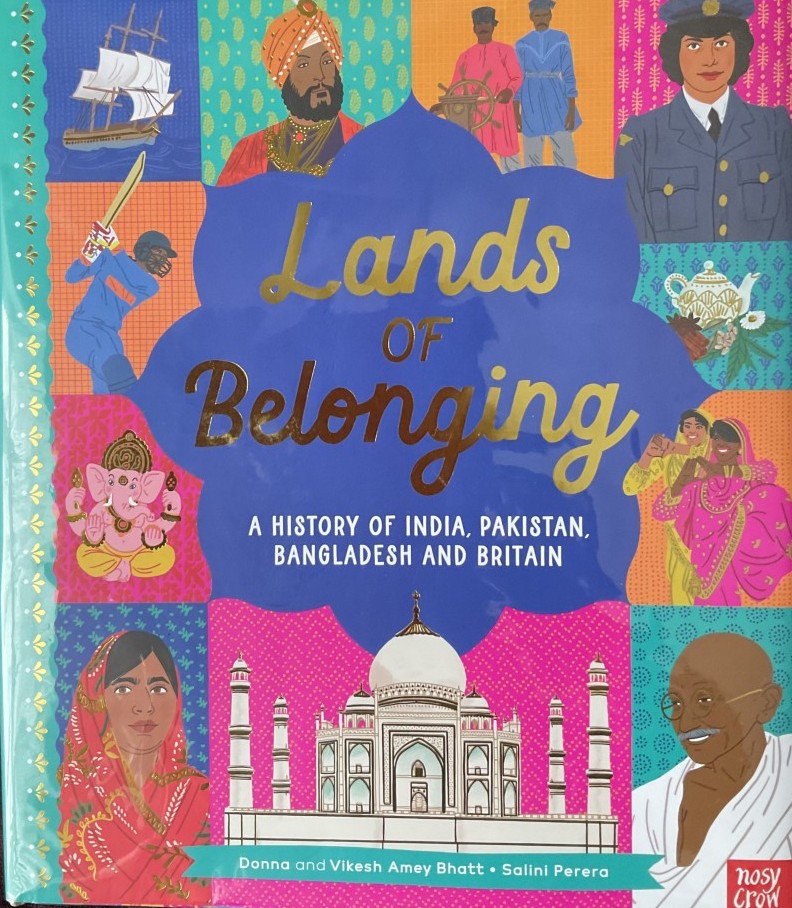Inspiring Young Readers
 posted on 18 Sep 2022
posted on 18 Sep 2022
Lands of Belonging: A History of India, Pakistan, Bangladesh and Britain by Donna and Vikesh Amey Batt, illustrated by Salini Perera
This informative and very interesting non-fiction book has been needed for a long time to redress the yawning gap in books written for children about the history and geography of this huge region. In fact, although the appealing format is aimed at a young audience, adults (myself include) will learn so much.
The visual impact of the beautiful cover coloured in bold pinks, blues and orange drew my attention in a bookshop as it was presented facing forward amid a display of relatively new books about Black history and Feminism. It is so good to at last see a range of such books in mainstream bookshops, particularly ones that relate to the UK. But this one shone out because there are, as yet, no others on the subject of the rich and complicated history of India, Pakistan, Bangladesh and Britain, and what it means to ‘belong’.
I was impressed at the way in which the authors frame the complexity in an enticing way from the start by focusing on why it is needed to look at history from different perspectives:
‘Often, the story of how South Asian and British history is tightly linked together isn’t explained in schools or in books … Turn the page to discover why Indian, Pakistani and Bangladeshi history is British history.’
What follows is an exploration of the idea of personal identity that is shaped by culture, experience, language and much more. Then we dive into the history and civilisation of Ancient India with some of its many inventions that precede European achievements. Through succinct illustrated overviews and a timeline stretching from 320 BCE to 1849, I learnt about a few of Ancient India’s most powerful Empires. I dimly remember covering the emerging spice trade during the Elizabethan expansionist era when I was at school, but no mention was made of how the East India company, formed in 1600, relied on military force and the relationship between trade and slavery. This book states the harsh reality more clearly:
‘Like most businesses, the aim of the East India Company was to make as much money as possible, not to look after a huge country full of people, making sure children went to school and that anyone unwell could find a hospital’.
The origins of the British Empire are well described and, although I now know about it, the sheer audacity of how, by 1913, Great Britain ruled over almost a quarter of the Earth’s land and its people is summarised in one double page spread with a map. This is powerful and as we are now being told, is, apparently, something to be very proud of.
The very readable text is embellished with colourful illustrations throughout and I loved the detailed colourful borders on the edge of each page. There are plentiful inserts with interesting facts to catch the eye. For instance, I didn’t know that Indian soldiers made up almost 29% of the total British army in The Second World War. And although I know a bit about the horrors of partition in 1947, I didn’t know that the man employed by the British government to organise the division based on religious belief ‘was given out-of-date maps and inaccurate information. He had no understanding of where different religious communities lived, or why, and instead divided India using information about railways and rivers’.
There is so much history in this book to digest and to be appalled by. But half way through we learn about the first South Asians to settle in Britain and the way in which people contributed to rebuilding Britain after WW2. Part of this more recent history focusses on the consequences of racism and the need to stand up for rights and social justice.
The final section of the book provides a softer, more comfortable and familiar overview of South Asian culture in terms of food, music, film, dance, sport and festivals. There are also tributes to celebrities new and old and how they continue to contribute to Britain.
But I was pleased to see that the final pages reiterated the overall purpose of the book:
‘Under British rule, the history of India, Pakistan and Bangladesh wasn’t always happy or fair, and at times it was unspeakably terrible’.
I really hope that it will be widely used in schools for children of all ages and also by students in colleges and universities as an accessible way to start digging into the past. Strongly recommended.
Karen Argent
September 2022




